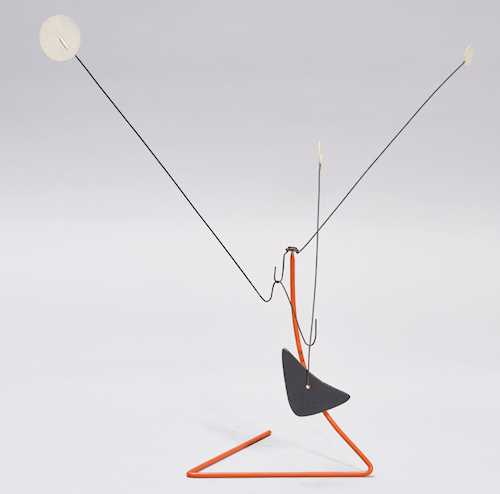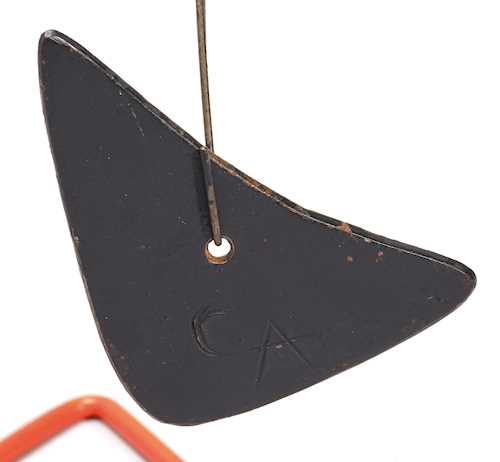
拍品 3433* - A211 战后和当代 - Donnerstag, 28. November 2024, 04.00 PM
ALEXANDER CALDER
(Lawnton 1898–1976 New York)
Three white dots on orange stack. 1952.
Sheet metal, metal rod, wire and lacquer.
With the incised monogramm on the black element: AC.
45 × 66 × 36 cm.
Provenance:
- Perls Galleries, New York.
- Waddington Galleries, London.
- Private collection, UK.
- The Mayor Gallery, TEFAF Maastricht.
- Private Collection, UK, acquired in the above gallery in 2011.
- Swiss collection.
Exhibited:
- Den Haag 2012, Alexander Calder – The Great Discovery, Gemeentemuseum, 11.2.–28.5.2012.
- St. Moritz 2020, Hauser & Wirth, 13.12.2019–9.2.2020.
- Paris 2021, Gogosian, 19.10.–18.12.2021.
Alexander Calder’s development of his iconic mobiles begins with a visit he paid to Piet Mondrian’s Paris studio in October 1930. The American artist describes this moment as “the pat on the back of a baby that gets the lungs working,” which produced “the shock that changed me” (Translated from J. Perl, Calder. The Conquest of Time: The Early Years, 1898–1940, New York, 2017, p. 338.) It is not the paintings that primarily impress Calder, but the light and brightness of the room and Mondrian’s use of colors, especially black, red and white. This visit makes Calder realize that abstract art can become something physical and three-dimensional: an all-encompassing experience.
The first kinetic sculpture was created in 1931, followed soon after by Calder’s mobiles, which established a new kind of art. In addition to the freely hanging “mobiles” – the term goes back to Duchamp – Calder also creates so-called “standing mobiles”, termed “stabiles” by Hans Arp. In these works too, movement and form merge into a unique interplay. Calder himself once said: “The mobile has an actual movement in it, while the stabile goes back to the old idea of painting with implied movement.” (Conversation with Katharine Kuh, 1962.)
“Three White Dots on Orange Stack” from 1952 is a wonderful example of Calder’s standing sculptures. With dimensions of 45 x 66 x 36 cm, the work combines the essential elements for which Calder is known: technical precision, playful lightness and sophisticated balance of movement and stillness. The fragile but perfectly balanced structure displays the harmonious connection between organic form and movement that characterizes Calder’s art. The three white-colored dots and the black triangle, which are placed on a delicate orange-red metal structure, seem to oscillate in perfect harmony with each other, while at the same time they are kept in dynamic balance through the ordering of the metal plates. The work is not static; it responds to its surroundings and shows a subtle interplay of movement and stillness.
The floating, amorphous forms, connected by fine black lines and found in many of Calder’s works, also arise from Calder’s interactions with his close confidant Joan Miró. Both artists are interested in bringing elements of spontaneity into their art, and both try to represent elements of nature through abstract forms. While in Miró these shapes adorn the atmospheric backgrounds of his paintings, in Calder they actually float in the air.
By reducing this work to just a few elements and concentrating on his three primary colors (red, white, black), Calder pays homage to minimalism that exhibits all the elegance of his kinetic art.
The first kinetic sculpture was created in 1931, followed soon after by Calder’s mobiles, which established a new kind of art. In addition to the freely hanging “mobiles” – the term goes back to Duchamp – Calder also creates so-called “standing mobiles”, termed “stabiles” by Hans Arp. In these works too, movement and form merge into a unique interplay. Calder himself once said: “The mobile has an actual movement in it, while the stabile goes back to the old idea of painting with implied movement.” (Conversation with Katharine Kuh, 1962.)
“Three White Dots on Orange Stack” from 1952 is a wonderful example of Calder’s standing sculptures. With dimensions of 45 x 66 x 36 cm, the work combines the essential elements for which Calder is known: technical precision, playful lightness and sophisticated balance of movement and stillness. The fragile but perfectly balanced structure displays the harmonious connection between organic form and movement that characterizes Calder’s art. The three white-colored dots and the black triangle, which are placed on a delicate orange-red metal structure, seem to oscillate in perfect harmony with each other, while at the same time they are kept in dynamic balance through the ordering of the metal plates. The work is not static; it responds to its surroundings and shows a subtle interplay of movement and stillness.
The floating, amorphous forms, connected by fine black lines and found in many of Calder’s works, also arise from Calder’s interactions with his close confidant Joan Miró. Both artists are interested in bringing elements of spontaneity into their art, and both try to represent elements of nature through abstract forms. While in Miró these shapes adorn the atmospheric backgrounds of his paintings, in Calder they actually float in the air.
By reducing this work to just a few elements and concentrating on his three primary colors (red, white, black), Calder pays homage to minimalism that exhibits all the elegance of his kinetic art.
CHF 450 000 / 600 000 | (€ 463 920 / 618 560)






